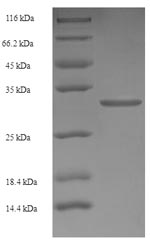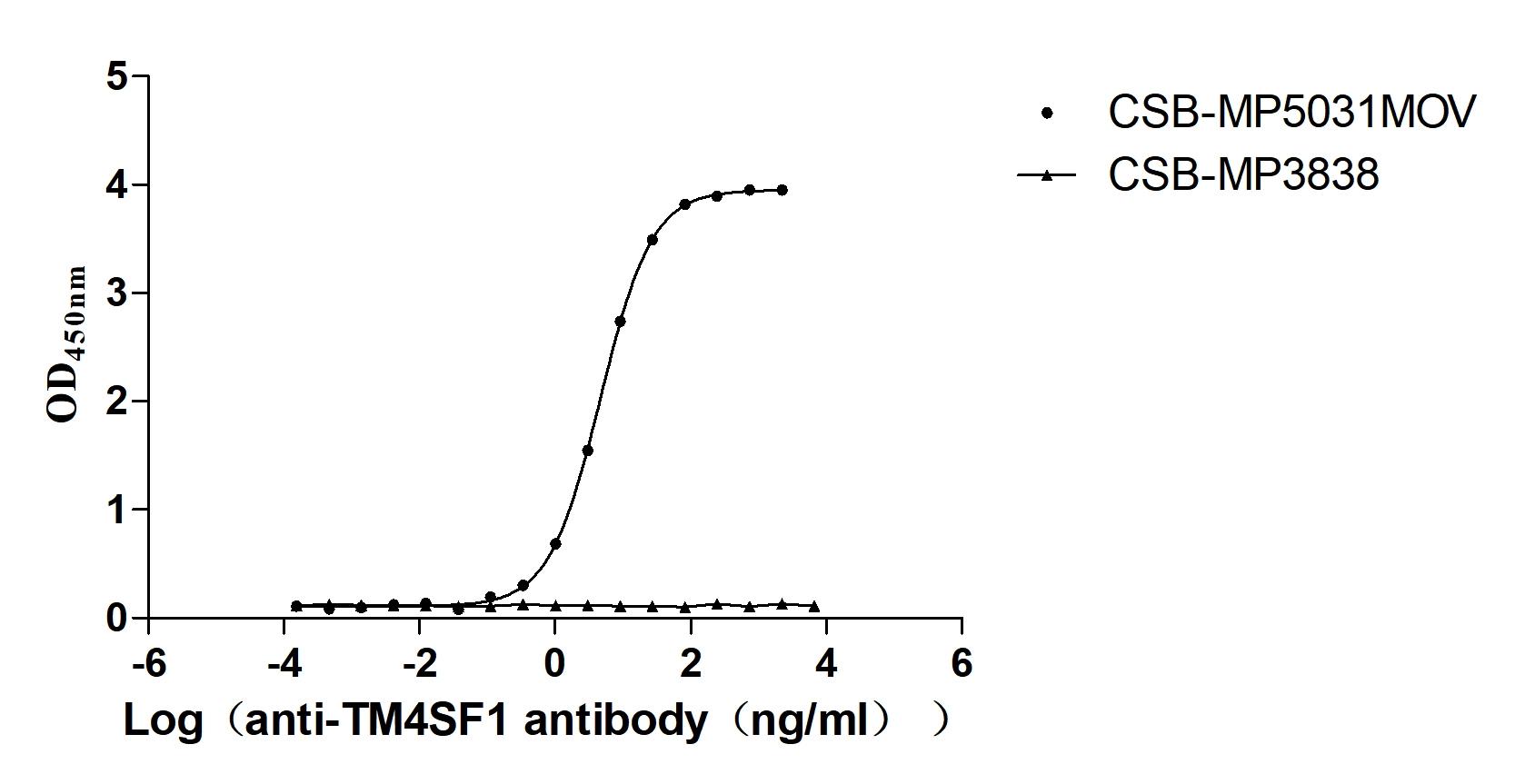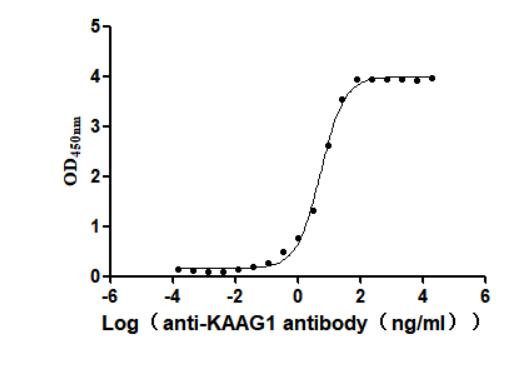Recombinant Human Retinoic acid receptor responder protein 2 (RARRES2)
In Stock-
中文名称:人RARRES2重组蛋白
-
货号:CSB-EP857881HU
-
规格:¥1344
-
图片:
-
其他:
产品详情
-
纯度:Greater than 90% as determined by SDS-PAGE.
-
基因名:RARRES2
-
Uniprot No.:
-
别名:HP10433; RAR responsive protein TIG2; RAR-responsive protein TIG2; RARR2_HUMAN; RARRES2; Retinoic acid receptor responder (tazarotene induced) 2; Retinoic acid receptor responder 2; Retinoic acid receptor responder protein 2; Tazarotene induced gene 2 protein; Tazarotene-induced gene 2 protein; TIG2
-
种属:Homo sapiens (Human)
-
蛋白长度:Full Length of Mature Protein
-
来源:E.coli
-
分子量:31.9kDa
-
表达区域:21-157aa
-
氨基酸序列ELTEAQRRGLQVALEEFHKHPPVQWAFQETSVESAVDTPFPAGIFVRLEFKLQQTSCRKRDWKKPECKVRPNGRKRKCLACIKLGSEDKVLGRLVHCPIETQVLREAEEHQETQCLRVQRAGEDPHSFYFPGQFAFS
Note: The complete sequence including tag sequence, target protein sequence and linker sequence could be provided upon request. -
蛋白标签:N-terminal 6xHis-SUMO-tagged
-
产品提供形式:Liquid or Lyophilized powder
Note: We will preferentially ship the format that we have in stock, however, if you have any special requirement for the format, please remark your requirement when placing the order, we will prepare according to your demand. -
缓冲液:Tris-based buffer,50% glycerol
-
储存条件:Store at -20°C/-80°C upon receipt, aliquoting is necessary for mutiple use. Avoid repeated freeze-thaw cycles.
-
保质期:The shelf life is related to many factors, storage state, buffer ingredients, storage temperature and the stability of the protein itself.
Generally, the shelf life of liquid form is 6 months at -20°C/-80°C. The shelf life of lyophilized form is 12 months at -20°C/-80°C. -
货期:3-7 business days
-
注意事项:Repeated freezing and thawing is not recommended. Store working aliquots at 4°C for up to one week.
-
Datasheet & COA:Please contact us to get it.
相关产品
靶点详情
-
功能:Adipocyte-secreted protein (adipokine) that regulates adipogenesis, metabolism and inflammation through activation of the chemokine-like receptor 1 (CMKLR1). Acts also as a ligand for CMKLR2. Can also bind to C-C chemokine receptor-like 2 (CCRL2), but with a lower affinity than it does to CMKLR1 or CMKLR2. Positively regulates adipocyte differentiation, modulates the expression of adipocyte genes involved in lipid and glucose metabolism and might play a role in angiogenesis, a process essential for the expansion of white adipose tissue. Also acts as a proinflammatory adipokine, causing an increase in secretion of proinflammatory and prodiabetic adipokines, which further impair adipose tissue metabolic function and have negative systemic effects including impaired insulin sensitivity, altered glucose and lipid metabolism, and a decrease in vascular function in other tissues. Can have both pro- and anti-inflammatory properties depending on the modality of enzymatic cleavage by different classes of proteases. Acts as a chemotactic factor for leukocyte populations expressing CMKLR1, particularly immature plasmacytoid dendritic cells, but also immature myeloid DCs, macrophages and natural killer cells. Exerts an anti-inflammatory role by preventing TNF/TNFA-induced VCAM1 expression and monocytes adhesion in vascular endothelial cells. The effect is mediated via inhibiting activation of NF-kappa-B and CRK/p38 through stimulation of AKT1/NOS3 signaling and nitric oxide production. Its dual role in inflammation and metabolism might provide a link between chronic inflammation and obesity, as well as obesity-related disorders such as type 2 diabetes and cardiovascular disease. Exhibits an antimicrobial function in the skin.
-
基因功能参考文献:
- chemerin and leptin are elevated and omentin-1 and visfatin levels are decreased in Gestational diabetes mellitus women complicated by obesity. PMID: 29337272
- The elevated levels of circulating TIG2 (chemerin) were associated with gestational diabetes mellitus.[meta-analysis] PMID: 30041634
- This study show the serum PARRES2 levels had significant positive correlation with seizure severity Chalfont score and the duration of epilepsy. PMID: 29860632
- findings of this study suggest that chemerin in synovial fluid may play role as a predisposing factor and may represent a novel potential prognostic biochemical marker in the pathogenesis of temporomandibular joint disorders PMID: 29331039
- G allele of chemerin rs17173608 compared to T allele decreased the risk of end-stage renal disease in a sample of Iranian population. PMID: 29644922
- Data suggest that down-regulation of serum levels of chemerin (an inflammatory cytokine biomarker) can occur in weight-loss therapy as short in duration as 4-week aerobic exercise plus dieting in obese female adolescents; this effect was not observed by dieting alone. This study was conducted in weight-loss summer camp in China. PMID: 29306931
- results demonstrate a strong inverse association between serum chemerin levels and renal function. PMID: 28833355
- The aims of this study were to evaluate and correlate circulating chemerin, apelin, vaspin, and omentin-1 levels in obese type 2 diabetic Egyptian patients with coronary artery stenosis (CAS), and to assess their usefulness as noninvasive diagnostic biomarkers. PMID: 28957639
- Data suggest that, in overweight and obese subjects, weight reduction induces changes in chemerin serum levels in parallel with adiponectin plasma levels; chemerin is down-regulated and adiponectin is up-regulated in both insulin-resistant and insulin-sensitive subjects after weight reduction; however, only changes in chemerin in insulin-sensitive subjects were found to be statistically significant. PMID: 28323510
- No associations were observed between SNPs in RARRES2 and obesity. PMID: 28947843
- Serum chemerin level during the first trimester of pregnancy has the potential to predict risk of gestational diabetes mellitus. PMID: 28454507
- The SD to LD transition was mimicked by 2 weeks of ICV infusion of human chemerin into rats. It also increased expression of the cytoskeletal protein vimentin, implicating hypothalamic remodeling in this response.Acute ICV bolus injection of chemerin on a 12 h:12 h photoperiod inhibited food intake and decreased body weight with associated changes in hypothalamic neuropeptides involved in growth and feeding after 24 hr. PMID: 27225311
- We studied the association between retinoic acid receptor responder 2 rs17173608 and rs4721 gene polymorphisms and gestational diabetes mellitus. We found that RARRES2 rs4721 polymorphism increased the risk of gestational diabetes mellitus. RARRES2 rs17173608 polymorphism is not associated with gestational diabetes mellitus. PMID: 29360607
- High chemerin expression is associated with metabolic complications. PMID: 28551507
- results show that chemerin not only increases osteoclasts activity in vitro, but also that increased level of chemerin in dyslipidemic mice plays a critical role in bone homeostasis. PMID: 28029186
- Suggest chemerin is a major factor in the secretome of senescent fibroblasts, promoting cutaneous squamous carcinoma cell migration, and possibly progression, relaying its signals through CCRL2 and GPR1 receptors with subsequent MAPK activation. PMID: 27907906
- Data suggest that chemerin acts at CMKLR1, but not GPR1, to increase blood pressure. Chemerin is expressed in vascular endothelium, smooth muscle, and adventitia. PMID: 27742615
- Data suggest that primary cells from papillary renal cell carcinoma secrete the chemokines IL8, CXCL16, and chemerin; these chemokines attract primary human monocytes and induce shift/transdifferentiation in monocytes toward M2 macrophage/foam cell phenotype. (IL8 = interleukin-8; CXCL16 = C-X-C motif chemokine ligand 16) PMID: 28759013
- Chemerin-CMKLR1 activates Akt/mTOR and ERK pathways and facilitates preadipocyte proliferation, adipogenesis, and angiogenesis. Gax weakens the effect of chemerin on preadipocyte biofunctions. PMID: 28326537
- study reveals the tumor-inhibitory effect of chemerin by suppressing inflammatory tumor microenvironment with therapeutic implications for inflammation-associated cancer-like Hepatocellular carcinoma. PMID: 28166197
- Further analysis of chemerin functions in vivo might constitute a crucial step toward optimizing Mesenchymal stromal cells-based therapy for inflammatory diseases. PMID: 27939374
- Stimulation of mesenchymal stromal cells (MSCs) by chemerin increases phosphorylation of p42/44, p38 and JNK-II kinases and inhibitors of these kinases and PKC reverse chemerin-stimulated MSC migration. PMID: 25127029
- Elevated chemerin levels in colons from ulcerative colitis patients correlate with disease severity PMID: 24727542
- cathepsin S and chemerin only correlated positively with insulin resistance and inflammation PMID: 24390241
- Cathepsin L- and K-cleaved chemerin trigger robust migration of human blood-derived plasmacytoid dendritic cells ex vivo PMID: 21715684
- Plasma chemerin levels are correlated with obesity, blood pressure, and high-density lipoprotein cholesterol, suggesting that it may play a role in the pathogenesis of metabolic syndrome. PMID: 24338392
- High serum RARRES2 expression is associated with Adrenocortical Carcinoma. PMID: 27336360
- Hypoxia-induced chemerin expression is mediated by TNF-alpha and at least in part by the ERK pathway PMID: 27792771
- Low chemerin and high resistin levels were associated with carotid disease severity, suggesting that these adipokines may act as potential markers for plaque instability and stroke risk. PMID: 27312219
- Serum chemerin concentrations are associated with the presence of atrial fibrillation and atrial remodeling. PMID: 27496791
- Chemerin mRNA is reduced in the liver of nonalcoholic steatohepatitis patients. PMID: 27797398
- Results show that chemerin stimulates the migration, invasion and proliferation of oesophageal cancer cells by a pathway sensitive to the ChemR23 antagonist CCX832. PMID: 27092781
- In type 2 diabetes mellitus, both chemerin and omentin enhance the body sensitivity to insulin, which results in increased glucose uptake PMID: 27516571
- High chemerin expression is associated with Overweight/obese. PMID: 27941174
- Circulating levels of the adipokine chemerin are elevated in lipodystrophy, as well as independently and positively associated with HbA1c and CRP. PMID: 26572532
- There was no difference in serum chemerin, vaspin and omentin-1 between polycystic ovary syndrome patients and healthy controls. PMID: 27225862
- Study demonstrated that circulating chemerin plasma levels are high in patients with chronic obstructive pulmonary disease. PMID: 24865134
- We conclude that LDL apheresis decreases the circulating level of chemerin by binding the protein to the column and thus improves lipoprotein subfraction pattern. PMID: 27756331
- The production of the two adipokines, chemerin and RBP-4, is strongly associated with obesity in patients with NAFLD. PMID: 27740519
- this study suggested that a role of STRA6 polymorphism could also be of value in predicting the risk of type 2 diabetes mellitus(T2DM) while RARRES2 polymorphism could not predict the risk of T2DM. PMID: 27446956
- Studied levels of salivary visfatin, chemerin, and progranulin and in gingivitis, periodontitis, as well as healthy patients. Salivary progranulin levels were similar in all groups; chemerin was detected at higher levels in the periodontitis group compared to the gingivitis and the healthy groups; visfatin levels were higher in patients with gingivitis and periodontitis compared to those of healthy subjects. PMID: 25164155
- Data show inverse Relationship of the CMKLR1 Relative Expression and Chemerin Serum Levels in Obesity with Dysmetabolic Phenotype and Insulin Resistance PMID: 27239101
- Oral lipid loading is linked to reduced circulating pro-inflammatory chemokines CCL2, IP-10, and chemerin and to increased RANTES levels, suggesting that dietary lipids affect immune function. PMID: 26950614
- Metabolic syndrome in Egyptian females is associated with the minor allele of chemerin rs17173608 polymorphism. PMID: 26472663
- Serum chemerin was significantly higher in the obese PCOS group compared with non-obese PCOS and the obese and non-obese control groups. PMID: 26291816
- The synovial fluid and synovial membrane levels of chemerin are increased in knee osteoarthritis patients PMID: 26722546
- Together, these findings suggest that CCL2, RARRES2 and EFNB2 are host cell factors involved in respiratory syncytial virus replication. PMID: 26277777
- serum chemerin may have a role in acute ischemic stroke and carotid artery plaque instability in Chinese populations PMID: 26471865
- Suggest reduction of chemerin could contribute to the antiobesity/antidiabetic properties described for alpha-lipoic acid. PMID: 26721419
- chemerin is a novel biomarker of dilated cardiomyopathy PMID: 26057200
显示更多
收起更多
-
亚细胞定位:Secreted.
-
组织特异性:Expressed at the highest levels in placenta, liver, and white adipose tissue (WAT), and to a lesser extent in many other tissues such as lung, brown adipose tissue, heart, ovary, kidney, skeletal muscle and pancreas. Within WAT, expression is enriched in
-
数据库链接:
HGNC: 9868
OMIM: 601973
KEGG: hsa:5919
STRING: 9606.ENSP00000223271
UniGene: Hs.647064
Most popular with customers
-
Recombinant Human Semaphorin-4D (SEMA4D), partial (Active)
Express system: Mammalian cell
Species: Homo sapiens (Human)
-
Recombinant Human Trophoblast glycoprotein (TPBG), partial (Active)
Express system: Mammalian cell
Species: Homo sapiens (Human)
-
Recombinant Human Desmoglein-2 (DSG2), partial (Active)
Express system: Mammalian cell
Species: Homo sapiens (Human)
-
Recombinant Human Interleukin-2 receptor subunit alpha (IL2RA), partial (Active)
Express system: Mammalian cell
Species: Homo sapiens (Human)
-
Recombinant Mouse Cytotoxic and regulatory T-cell molecule (Crtam), partial (Active)
Express system: Mammalian cell
Species: Mus musculus (Mouse)
-
Recombinant Macaca fascicularis Transmembrane 4 L6 family member 1 (TM4SF1)-VLPs (Active)
Express system: Mammalian cell
Species: Macaca fascicularis (Crab-eating macaque) (Cynomolgus monkey)
-
Recombinant Human Kidney-associated antigen 1(KAAG1) (Active)
Express system: E.coli
Species: Homo sapiens (Human)
-
Recombinant Human Kidney-associated antigen 1(KAAG1) (Active)
Express system: Baculovirus
Species: Homo sapiens (Human)





















